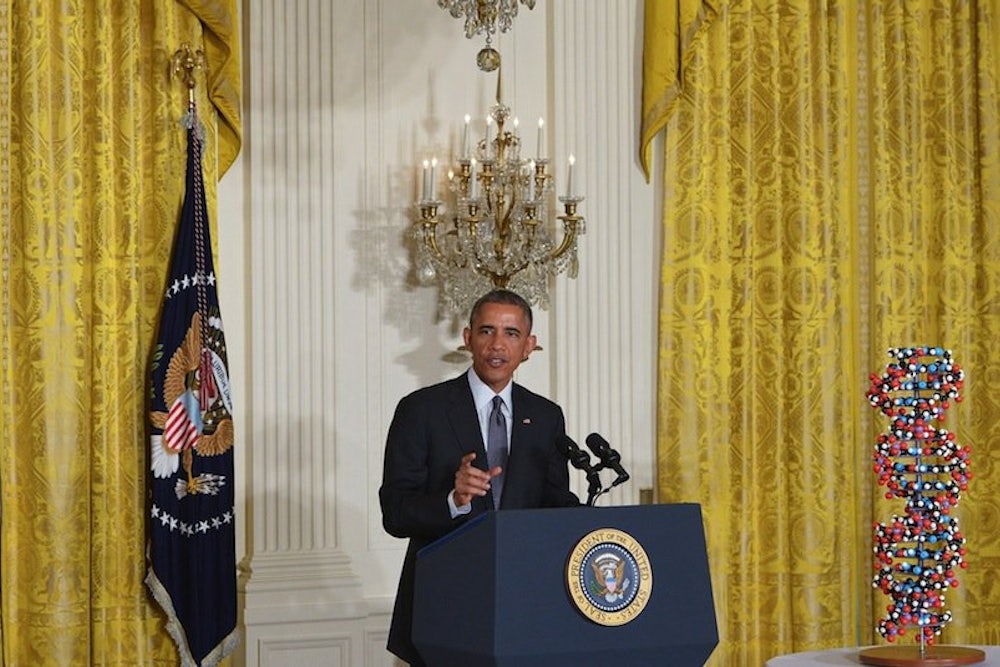Today the Obama Administration announced a $215 million “precision medicine” initiative. It has a handful of objectives based on an underlying goal: to facilitate the pooling of health data in order to better tailor treatments to individual patients. In the administration’s words:
Most medical treatments have been designed for the “average patient.” As a result of this “one-size-fits-all-approach,” treatments can be very successful for some patients but not for others. This is changing with the emergence of precision medicine, an innovative approach to disease prevention and treatment that takes into account individual differences in people’s genes, environments, and lifestyles.
When it comes to genetic diseases, like certain types of cancer, a person’s health or sickness is coded in his DNA. When a person undergoes treatment for a disease, parts of his DNA or his entire genome may be sequenced, with his permission, in search of a mutation linked to his disease. Looking at the DNA of cancer patients has produced life-saving preventative measures, enabling doctors to determine if a healthy person has a genetic mutation that could put her at risk for a disease later in life. For instance, when Angelina Jolie announced that she’d had a preventative double mastectomy in 2013, it was because she had a mutation in her BRCA genes that is linked to breast cancer. Discoveries enabled by genetic sequencing have also shed light on how a person responds to a treatment, as the White House fact sheet noted.
For years, doctors, researchers, and patient advocacy groups have been pushing for medical-data pooling, which would take health data, like an individual’s genome and also information like cholesterol and blood pressure, of millions of people and create a database that would allow for deeper research into how various genes can influence the onset of a disease and how an individual responds to treatment. Hundreds, even thousands, of scientific breakthroughs could result from such a database.
In October of 2012, John Wilbanks, an advocate of pooling health data, gave a TEDTalk on the topic that has been viewed over 470,000 times. In his talk, Wilbanks opens by harking back to the early days of medicine, describing how people used to look to the gods for medical explanations, eventually moving toward science and modern medicine and the art of the clinical study. But the march of progress isn’t so straightforward. If we look at the history of western medicine, particularly in regard to “patient-powered” (to quote the White House) approaches to treatment, the president’s initiative isn’t innovative at all. It’s retro.
For most of the history of western medicine, treatments tailored to specific patients were the only treatments that existed. Physicians practiced humoral medicine from the days of the ancient Greeks up through the 1800s. Diseases were believed to be caused by imbalances in the body, which could be cured by recalibrating the person’s internal state. Bloodletting is the most famous treatment from the days of humoral medicine, but physicians factored in food, exercise, the weather, the climate, family medical history, age, social status, and experience into diagnosing and treating patients. Disease was seen as a product of how a person’s particular chemistry interacted with his environment.
Then in the late 1880s, the bacteriological revolution changed everything. Disease came to be understood in terms of germs and bacteria, a war between malevolent microorganisms and a species empowered by antisepsis, disease-specific research, and the cool confidence and competence assured by a successful clinical trial. Even our language for genetic diseases reflects our war on germs: We fight cancer. In doing so, we create a division between the part of a person that has made her sick and the part that is trying to make her well again. But as the White House points out, “one-size-fits-all-approach” treatments are a fallacy. Understanding what made a specific someone sick may be the key to creating more efficient treatments—for that someone, and for others.
The idea of swapping patients’ personal details has a historical precedent, as well. Historically, physicians often wrote letters to each other about the stranger cases they came across, hoping to pool knowledge. Privacy laws didn’t protect patients until relatively recently, and two doctors sharing what they’d seen could certainly help a sick patient in the care of an inexperienced physician. Today, we have journals where medical breakthroughs are published, but often patients themselves have valuable information that isn’t shared because they simply aren’t asked, an effect of the bacteriological revolution, or that is deemed irrelevant because of how we prioritize medical information and execute clinical trials. Pooling all available health data for an enormous population of people would not only help doctors seeking guidance on a specific ailment, it would also allow for research into genetic cause-and-effect relationships previously seen as too obscure, too much a shot in the dark, to get funding. Consider the case of Kim Goodsell, who, in 2002, taught herself the language of genetic literature and cracked the case on her own genetic mutation when doctors didn’t initially theorize that the two rare conditions she had were very likely related.
The White House’s announcement today could be seen as a progressive move, an extension of the open-source culture that is celebrated online. It’s certainly an initiative that many in the medical community would agree is long overdue. But it could also be seen as a return to a more humanist approach to medicine, a step in correcting for a chapter in modern medical history that introduced live-saving technologies, though often at the cost of trivializing the individuality of every patient. Genomic technology will likely yield leaps and bounds in the treatment of genetic diseases—especially if genomic breakthroughs are shared democratically and applied on a patient-as-an-individual basis.
